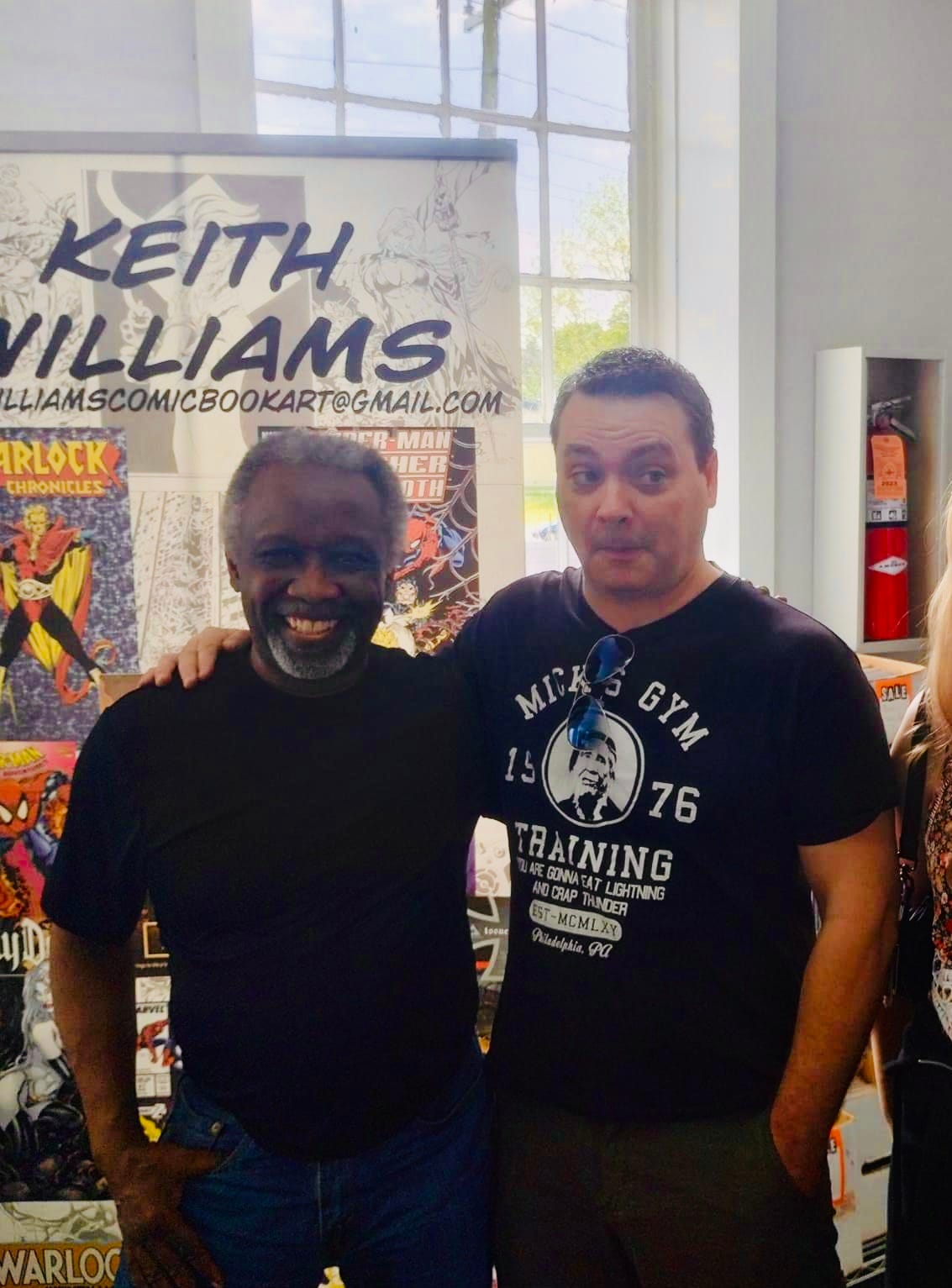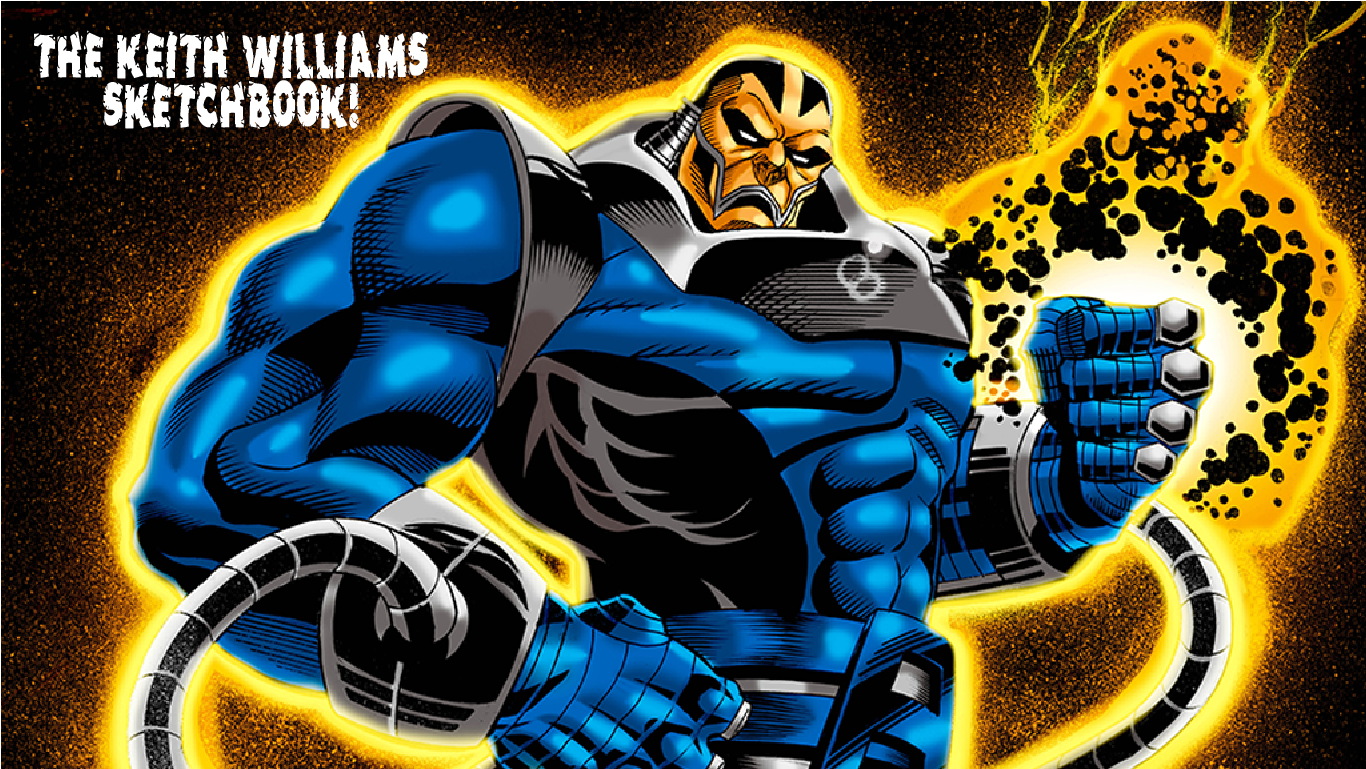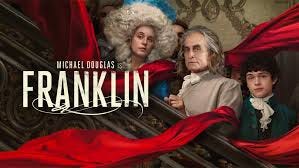If both of us are appearing at the same comic convention, there’s a good chance the show’s organizer will table me next to Keith Williams; there aren’t that many Keiths working in the comic book industry so…I guess it’s cute?
I’m not complaining, don’t get me wrong. Mr. Williams, aside from being a legendary ink artist for his work at Marvel Comics from the 80’s on, is also one of the three nicest people I’ve met in the industry. Particularly (and having had a front row seat many times), I’ve learned a lot from the way Keith treats the fans that come to his table. His ability to be present through these interactions, which I’ve often seen last 30-45 minutes, and the way he treats everyone with respect, patience and kindness no matter how many drawings he’s quietly rushing to finish, is something I really admire.
Secondary to that, Keith is a terrific inker and artist and, on the occasion of New Pain’s crowdfunding campaign for the first KEITH WILLIAMS SKETCHBOOK, I forced him to talk to ME for 30-45 minutes and figure out where this guy came from and what makes him tick. I hope you’ll enjoy this conversation with one of my favorite people.
KC: Keith, let’s start off at the very beginning, chicken and egg stuff. At what age does young Keith Williams discover comic books? Any titles stand out as early favorites?
KW: I must have discovered comics at the age of nine. That was around 1966-67.My Grandma gave me one of my first comic books, Batman 184. I remember it because of the cobwebs—
KC: I know exactly the issue you mean!
KW: Right? The cobwebs that were hanging off the faces of Batman and Robin! She would give me comic books just about every weekend. I just felt compelled after a time to see if I could draw my own comic. They were all stick figures of course but that didn't stop me from trying.
KC: That was actually my next question. Had you started drawing before you discovered comic books, or did comic books stimulate a desire to be an artist?
KW: It’s hard to say, really. I do remember when I was at South Shore High School, I entered an art contest for stopping pollution and won first place. My advisor arranged for me to take major art classes in the 10th grade and off I went.
In the 11th grade I won the right to create the yearbook cover for my school and also did the art for school shows. After high school, I then went to the School of Visual Arts and studied under the Spirit's creator, Will Eisner.
KC: It’s hard to imagine a better environment, or instructor, to really grind the form of comics into someone. And then becoming a Romita Raider, it’s almost like you were destined for comic book glory!
KW: Let’s not get carried away, Keith. When I finally did make it through the door at Marvel, I overheard that they were creating an internship/art corrections program to be run by John Romita, who was Marvel’s art director at the time.
Needless to say, I jumped at the chance to learn from such an amazing artist and became the very first Romita Raider.
KC: Wow, I had no idea you were the very first raider! I never got to meet Romita Sr but he seems like practically a saint, from what everyone tells me. Who were the other raiders at the time?
KW: In the early days of the program, I worked with Phil Lord and Steve Geiger and I guess the most fun we had was watching John draw and listen to his stories.
KC: I can only imagine the stories; especially the Stan Lee stories. What was your very first professional, non-production art, credit?
KW: My first published art was as a background inker on Marvel Team-Up, working with Mike Esposito over Jim Mooney's pencils.
KC: I always loved Jim Mooney’s stuff. His art was super solid and everything he drew just seemed…friendly. Weird way to describe it, I guess.
KW: It was nerve wracking but also fun and that job was offered to me by Don Perlin. My first professional, solo credit was in Sectaurs, inking over Steve Geiger's amazing pencils.
KC: I always felt that Geiger would have been a huge name in comics if he were half as interested in drawing as he was in being a rock star. I forget the name of his band but found out from Steve that they came really close to making it big. Aside from Geiger, any personal favorite artists you've inked? You worked with virtually everyone over the years; in fact, you and I are Eskimo brothers with a few different pencil artists.
KW: I don’t want to know what that means.
KC: Yeah, maybe you don’t. But who did you enjoy the most, or feel you gelled with best, stylistically?
KW: There have been so many great artists I’ve been lucky to work with, it’s hard to really say. I few that stand out and were people I enjoyed inking over like Alex Saviuk, John Byrne, Greg Capullo and George Olesen do come to mind. It was terrifying and fun at the same time.
KC: We have Byrne in common, although I only worked with him on a 10-page story I also wrote. He was great with me but John is known to not suffer fools. Which is weird because I’m definitely a fool. How have you handled working with difficult personalities, either editorial or artistic?
KW: Just live and learn. Be respectful and open minded. If something I inked didn't look right , the editor would tell me and I would try to fix it or do better the next go around. There were also artist like John Romita and Jack Abel who you could go to to get some wisdom, if you needed to.
KC: I love how you just casually name drop all these great names from back in the day. Jack Abel is another guy that everyone should adore, if they don’t already. So let me start to wind this up because even you can only take so much of me.
After decades working as an inker, you suddenly decide to focus on your drawing skills instead. When it comes to penciling...why?! Drawing is hard, why not take a nap instead?
KW: There was a phase in the early 2000’s, I guess, when Photoshop came along and suddenly, pencillers started darkening their lines digitally instead of working with an inker. Luckily, it didn’t really catch on but I realized that the industry was changing and at the turn of a dime, I could be out of a job as an inker.
I decided that I had to relearn to draw to stay relevant. It wasn't easy; it’s never easy but I love doing the thing that drove me to get into the business in the first place.
KC: Aside from working behind the drawing table, it often doesn’t seem like a weekend goes by where you’re not appearing at a comic book convention. I get exhausted just looking at your schedule! What keeps you going, what do you enjoy about doing conventions?
KW: Now, at over 40 years in the comic book business, I'm at the stage where I go to conventions, a lot. I'm amazed at the amount of people who recognize my ink work, that the books I worked on mean so much to some people.
KC: You’re absolutely the best listener I’ve ever seen, and that’s a skill!
KW: I enjoy listening to their stories! Hearing about people’s love of comic books, sci-fi, horror, mystery, it’s all stuff I love too! And I also enjoy telling…hopefully coherent…stories about my life as a comic book artist.
KC: Having been able to hear a lot of your stories, I can confirm that they’re coherent. And great! Wrapping up, Keith, any advice you’d give to someone just breaking into the business today?
KW: I think some of the lessons I've learned in the pursuit of becoming a comic book artist would be to listen to the people that were there before you. There's always something new to learn. Take criticism and make it work for you.
Work hard, be kind and treat people the way you would want them to treat you. And see each day as a new experience doing a job that you love.
KC: Easier said than done sometimes. Thanks for doing this, Keith!
MEDIA ROUND UP
For those of you dying to know, I really enjoyed Kingdom Of The Planet Of The Apes. I thought it was clearly the start of a new trilogy in the Apes franchise which is A-OK by me. The color and musical palette in the flick really harkens back to the original 1968 film which was a nice touch for POTA nerds like me.
Lately, I’ve been enjoying FRANKLIN, on APPLE TV. I remember trying to read the book the show is based on (A Great Improvisation, by Stacy Schiff) but there weren’t enough pictures for my taste and I don’t remember ever finishing the book. But that works out because now, this adaptation is fresh and new to me!
Michael Douglas isn’t the first actor I’d have chosen to portray Ben Franklin; Not that he’s bad at all, I just find him a bit too recognizable in the part at times. Still, the cast around him are all excellent, as are the production values of the show. Between Franklin and Shogun, historically accurate fiction is having quite a moment.
I’m roughly 2/3rds through the season and, as intrigue and machinations build and swirl around randy ol’ Ben (maybe that’s why they cast Michael Douglas?), the story and pacing has come to match the production values and the series has become quite a fun watch. Spoiler alert: we all kind of know, in the big picture, how things are going to end up for Ben Franklin and America but getting there is half the fun. New Pain Pro gives Franklin its official recommendation, I’m sure they’ll sure to advertise that endorsement to the moon!
THAT’S ALL…
That’s all for this edition, friends. Back soon! If there’s an industry pro you’d like to see interviewed (NOT TOM NGUYEN, PLEASE!), drop it in the comments. And if you’d be so kind, please check out THE KEITH WILLIAMS SKETCHBOOK and think about supporting one of the truly good guys in an often hard-to-like industry.








Keith, this was a fantastic article and I could not agree with you more...Keith Williams is one of the most friendly and personable people you will ever meet!
Next for you? Talk to Bob Hall about being Forked in Baltimore! LOL, he will know what it means!